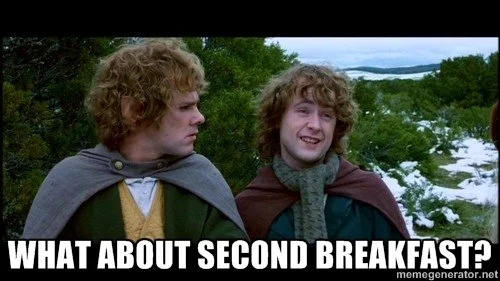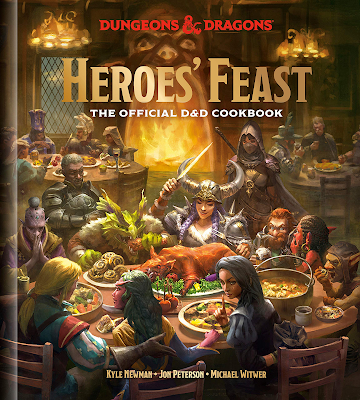I came up with this while posting on a training log in t-nation and it was so good I had to write it out. I’m going to cop to the fact that I’ve never read a single JRR Tolkien book and have only watched the Lord of the Rings Movies and that my “knowledge” of that universe is really more from Dungeons and Dragons, so for the true nerds out there: I apologize for appropriating your culture and all the mistakes I’m about to make, but bite me, because this is my blog.
 |
| You're welcome for your stat boost |
All that aside, for all you folks out there looking for “fitspiration”, you can do no better than these 3 fantasy creatures: the Hobbit (Halfling to you civilized folks), Orc and Ogre. First, what’s great about picking a fantasy creature is that the lie happens UP FRONT. You don’t need to worry about genetics, drugs, photoshop, filters, SARMS, surgery, synthol or any other insanity: it’s CLEAR that this is all make believe. And any of you who have read my blog previously KNOW that I am a much bigger fan of being inspired by wildly impossible myths and legends than anything even remotely resembling reality. If you try really hard to be like Kaz and you fail, well that sucks, but if you were trying REALLY hard to be like The Juggernaut and you fail…well you never had a shot kid!
Ok, that’s 2 intros: I should actually write something now. Let’s talk about eating like a Hobbit.
WHY EAT LIKE A HOBBIT?
Hobbits have it figured out. Eat FREQUENTLY! Boy will I beat this drum forever. I am ALWAYS eating. I think of it like “grazing”, but anyone that read through my reviews of Deep Water/Building the Monolith observed my every 30 minute approach to eating SOMETHING, to say nothing of the giant meals I have at the beginning and end of the day (reference my “Bookending” post).
Frequent eating became big in the 90s due to the idea that it “stoked the metabolic fires”. Some suggest the idea that, if the body is fed constantly, it knows that food is in abundance and, in turn, won’t store bodyfat. Science, of course, has come out and denied all of this…and then there will be a study next week that affirms it, and whatever. Use some solipsism and just make this work for you!
Frequent eating is awesome no matter the goal. Want to gain weight? Know what stops a lot of people? Feeling FULL! You eventually run out of room in the guts and can’t eat more. Well, that happens when you have a goal of eating 4000 calories and only 3 meals to get it done: those are 3 HUGE meals. You are NOT going to feel happy about that. Chop it into 6? Smaller meals: easier on the guts. 6 meals and 3 snacks? Now we’re really getting somewhere. I’m a total d*ck at work because whenever I’m eating someone will make some stupid comment like “You’re eating ground beef for breakfast?!” and I reply “I got up at 0305 and this is my 5th meal of the day: I don’t bother naming them any more”.
 |
| But I suppose that works |
Losing weight? Frequent eating is a FANTASTIC way to bridge the gap of time. People fail weight loss because they are HUNGRY, and, eventually, they let hunger override logic and just binge at the end of the day. That’s the absolute worst, because you suffered ALL day AND undid all that work at the end, so you feel bad for failing AND you felt bad all day suffering. With frequent eating, you never have to be hungry for long. Instead of it being 6 hours until your next meal, it can be 3. The more frequent, the shorter the time. No: you won’t eat until you are FULL, but you CAN eat enough to no longer be starving. And, if nothing else, you can deceive yourself into thinking you had “enough”.
Break away from the 3 meal a day constraint. It’s a manufactured concept. There’s nothing special about breakfast, lunch and dinner: have second breakfast, tea, elevensies, and all the other names they came up with for meals. Or do like I do and quit naming them and just eat. But either way, eat like a Hobbit. We don’t eat like Orcs, who engage in ritual feasts, filling up at giant meals before soldiering off for battle. We don’t eat like Ogres, going for long periods of fasting/starving before landing an ambush and absolutely gorging themselves because they don’t know when the next meal is coming. We will find a way to get in a meal no matter what the situation.
WHY TRAIN LIKE AN ORC?
Orcs are the mortal and sworn enemy of the elves along with the dwarves. And elves and dwarves don’t necessarily get along either, so when two diverse people can come together in harmony over how deplorable they find you, you know you’re a bad people. Both the elves and dwarves have formed well trained and regimented military units, highly trained in tactics and equipped with well forged (and often magical/mythical) weapons and armor in order to combat the Orcish threat.
A threat, mind you, comprised of a bunch of razor toothed lunatics outfitted in animal hides armor with rusted steel and no actual strategy.
 |
| What he lacks in nuance he makes up for in GIANT F**KING HAMMER |
Because, for what that threat lacks in battlefield skill, weapons and training, it compensates for with sheer brutal intensity and insanity. The Orcs personify “bloodthirsty”. They are not here to fight: they are here to kill. THAT is what you need to bring to training. THAT is the “secret”. Because not all of us will be so lucky to get magical chain armor that is weightless, or an enchanted axe, or the blessings of the gods, but ALL of us have a choice to be brutal, savage and crazy, and those of us that pick that choice can be a threat to those that are blessed.
We don’t train like Hobbits: they are soft and too used to the good life. They fight begrudgingly, often preferring to hide. We don’t train like Ogres: as fearsome as they are, they are inherently lazy, relying on ambushes, sneak attacks, and their natural gifts of size and strength over a weaker foe. We train like the Orc: willing to take on foes 3 times their size because their berserker bloodlust frenzy compels them to die on their feet. They are “will to power” personified. They are intensity.
WHY THINK LIKE AN OGRE?
 |
| Peep that intel score of 5 |
An odd choice no? The ogre is not historically appreciated for their intellect. Quite the opposite, of course. Ogres are known for their stupidity: for their single-minded drive toward filling their bellies and satiating their lusts and, otherwise, sulking off and being left alone. They are no mighty wizard, controlling magic through intellect, they are no Gandalf or sage. Why would we think like them?
BECAUSE they are so stupid! Folks: we’re trying to get big and strong here. We’re the meatshield of the party. We are the barbarian. NO ONE is expecting us to be the genius here. Save that for the wizards and bards: they’re super fun to talk to at the tavern…AFTER you survive the battle. And that last part requires the ogre-like intellect found within the tank of the party. And trust me: those wizards and bards are GREATFUL that their “none-too-smart” friend was there to STOP thinking and START smashing.
 |
| He was handy in the right situations |
Because ACTION is far more valuable than inaction here. Folks, I know people that didn’t go to the gym because they were “researching programs still”. Are you f**king kidding me?! Look: I’ve read a ton of books on lifting weights too. It can be fun to do. But BEFORE I did that, I was doing SOMETHING. I wasn’t getting bogged down in the details: I was chasing after my goals with a single-minded drive.
No plan, no strategy, just start smashing stuff and, when the stuff is dead, start eating stuff.
And when you smash the stuff, smash it with the intensity of the Orc.
And when you eat the stuff, eat it like a Hobbit.












